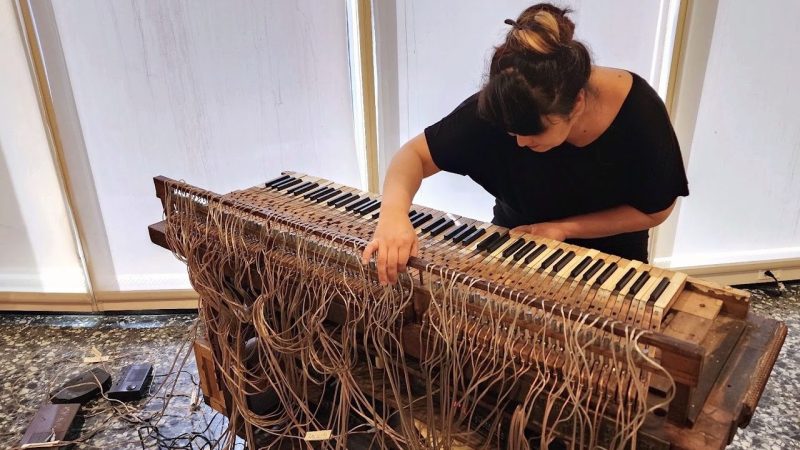Pianos use little hammers striking taut strings to make tones. The Mellotron used lots of individual tape mechanisms. Meanwhile, the Trans-Harmonium from [Emily Francisco] uses an altogether more curious method of generating sound — each key on this keyboard instrument turns on a functional clock radio.
Electrically, there’s not a whole lot going on. The clock radios have their speaker lines cut, which are then rejoined by pressing their relevant key on the keyboard. As per [Emily]’s instructions for displaying the piece, it’s intended that the radio corresponding to C be tuned in to a local classical station. Keys A, B, D, E, F, and G are then to be tuned to other local stations, while the sharps and flats are to be tuned to the spaces in between, providing a dodgy mix of static and almost-there music and conversation.
It’s an interesting art piece that, no matter how well you play it, will probably not net you a Grammy Award. That would be missing the point, though, as it’s more a piece about “Collecting Fragments of Time,” a broader art project of which this piece is a part.
We do love a good art piece, especially those that repurpose old hardware to great aesthetic achievement.















Wouldn’t it make more sense to use the alarms instead of the radios?
As I understand it, it isn’t about playing music at all.
The radios are tuned to different stations. As you “play” the keyboard, what you hear varies with which keys the player presses as well as the content of the radio program.
The resulting (non-repeatable) mish-mash is the intended result – a mix of the player’s key sequence and timing and the sound of whatever is on the ether at that moment.
Look at it as more of a statement on transient nature of art and music than as a musical instrument.
That doesn’t make the sounds it produces into music (or anything I want to hear,) but it does give it a context.
There was an artist that made music out of clipping public broadcast radio and using those as samples. Can’t remember the name. Some of it was pretty catchy.
The birds fly a lot better than we do.. See how they wheel and bank, all in one..
It was John Cage https://en.wikipedia.org/wiki/John_Cage one of the best known protagonists of “new music” along with Karl Heinz Stockhausen. And the piece you referred to is “Imaginary Landscape No. 4″ for 12 radios”
The case you referred to was “Imaginary Landscape No. 4″ for 12 radios”
https://www.youtube.com/watch?v=A0BNsBlzQII
From John Cage
https://en.wikipedia.org/wiki/John_Cage
one of the most prominent representatives of “now music” (“Neue Musik”) besides Stock hausen and Mauricio Kagel.
Was one of them tuned to 90.1? Asking for a friend.
C-SPAN? Might was well tune it to the static, like all the flats.
Hey pal, that’s my radio station. Like literally. Those are fighting words!
The Trans-Harmonium is currently located at the Media Archaeology Lab in Boulder, CO. I ama volunteer there and I can confirm that a few of the radios are tuned to 90.1FM, which is our local Colorado Public Radio station.
When it was in DC in the video it would be tuned to C-SPAN radio at the same frequency.
that’s beautiful! I used to tune my pocket size shortwave radio to some fading station when I couldn’t sleep ,always worked to make me hit bed in no time.
tom recchion would be proud
A, adult alternative. B, Bible readings. C, NPR classical. D, death metal. E, electronica. F, far off GOP talk. F#, blues. G, GNW?-spin the dial.
This reminds me strongly of the way the aliens on the series Greatest American Hero communicated with humans, by tuning the (in the day manually tuned variable capacitor) car radios to different stations to pick and choose just the right words to construct sentences to give instructions.
It thrills me nearly as much as Bauhaus architecture!
I wonder if you’d get interesting results if you use ambient noise passed through bandpass filters, with the center of each tuned to what the piano note would be. The results would vary a lot with the environment.
Oh… I guess I’ve just described a sampler. Anyway, since it would be easy to achieve with a DAW, maybe I’ll try it.